29.1 Phylum Chordata
Learning Objectives
- Describe the distinguishing characteristics of chordates
- Identify the derived characters of craniates that sets them apart from other chordates
- Describe the developmental fate of the notochord in vertebrates
Vertebrates are members of the kingdom Animalia and the phylum Chordata (Figure 29.2). Recall that animals that possess bilateral symmetry can be divided into two groups—protostomes and deuterostomes—based on their patterns of embryonic development. The deuterostomes, whose name translates as “second mouth,” consist of two major phyla: Echinodermata and Chordata. Echinoderms are invertebrate marine animals that have pentaradial symmetry and a spiny body covering, a group that includes sea stars, sea urchins, and sea cucumbers. The most conspicuous and familiar members of Chordata are vertebrates, but this phylum also includes two groups of invertebrate chordates.
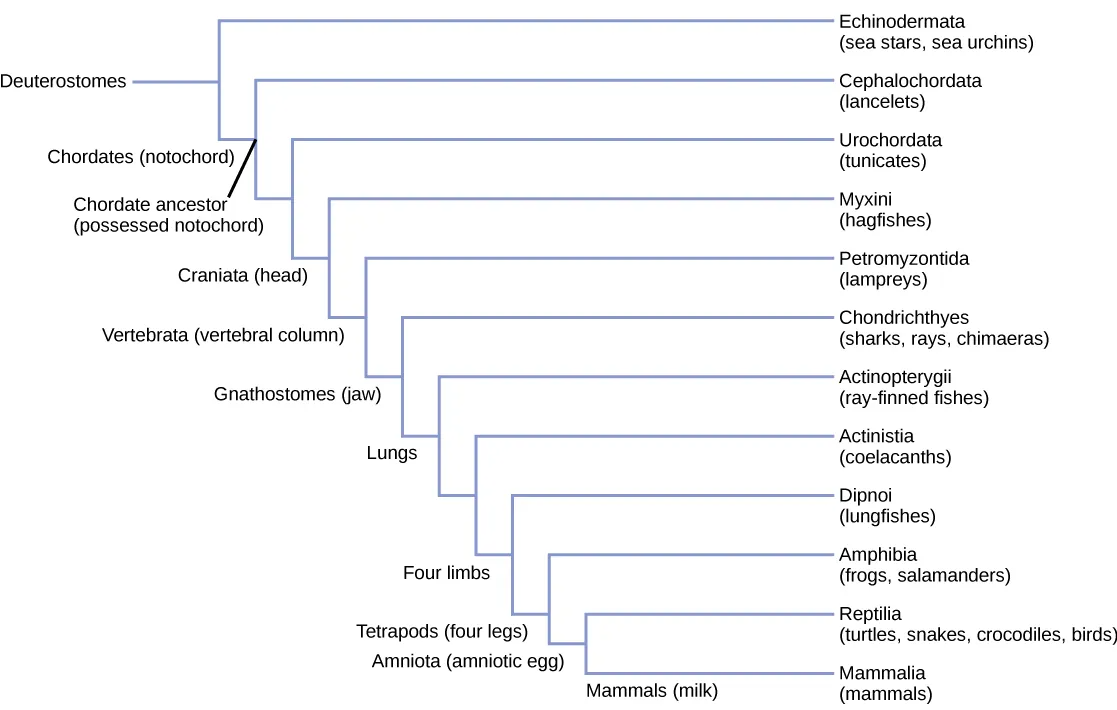
Characteristics of phylum Chordata
Animals in the phylum Chordata share five key features that appear at some stage of their development: (Figure 29.3)
- Notochord
- Dorsal hollow nerve cord
- Pharyngeal slits
- Post-anal tail
- Endostyle/thyroid gland
In some groups, some of these traits are present only during embryonic development. In addition to containing vertebrate classes, the phylum Chordata contains two clades of “invertebrates”: Urochordata (tunicates, salps, and larvaceans) and Cephalochordata (lancelets).
Notochord
The chordates are named for the notochord, which is a flexible, rod-shaped mesodermal structure that is found in the embryonic stage of all chordates and in the adult stage of some chordate species. It is strengthened with glycoproteins similar to cartilage and covered with a collagenous sheath. The notocord is located between the digestive tube and the nerve cord, and provides rigid skeletal support as well as a flexible location for attachment of axial muscles. In some chordates, the notochord acts as the primary axial support of the body throughout the animal’s lifetime. However, in vertebrates (craniates), the notochord is present only during embryonic development, at which time it induces the development of the neural tube and serves as a support for the developing embryonic body. The notochord, however, is not found in the postembryonic stages of vertebrates; at this point, it has been replaced by the vertebral column (that is, the spine).
Visual Connection
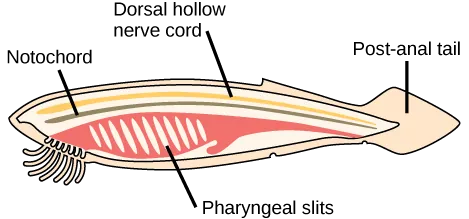
Dorsal hollow nerve cord
The dorsal hollow nerve cord is derived from ectoderm that rolls into a hollow tube during development. In chordates, it is located dorsally to the notochord. In contrast, the nervous system in protostome animal phyla is characterized by solid nerve cords that are located either ventrally and/or laterally to the gut. In vertebrates, the neural tube develops into the brain and spinal cord, which together comprise the central nervous system (CNS). The peripheral nervous system (PNS) refers to the peripheral nerves (including the cranial nerves) lying outside of the brain and spinal cord.
Pharyngeal slits
Pharyngeal slits are openings in the pharynx (the region just posterior to the mouth) that extend to the outside environment. In organisms that live in aquatic environments, pharyngeal slits allow for the exit of water that enters the mouth during feeding. Some invertebrate chordates use the pharyngeal slits to filter food out of the water that enters the mouth. In vertebrate fishes, the pharyngeal slits are modified into gill supports, and in jawed fishes, into jaw supports. In tetrapods (land vertebrates), the slits are highly modified into components of the ear, and tonsils and thymus glands. In other vertebrates, pharyngeal arches, derived from all three germ layers, give rise to the oral jaw from the first pharyngeal arch, with the second arch becoming the hyoid and jaw support.
Endostyle
Endostyle is a strip of ciliated mucus-producing tissue in the floor of the pharynx. Food particles trapped in the mucus are moved along the endostyle toward the gut. The endostyle also produces substances similar to thyroid hormones and is homologous with the thyroid gland in vertebrates.
Post-anal tail
The post-anal tail is a posterior elongation of the body, extending beyond the anus. The tail contains skeletal elements and muscles, which provide a source of locomotion in aquatic species, such as fishes. In some terrestrial vertebrates, the tail also helps with balance, courting, and signaling when danger is near. In humans and other great apes, the post-anal tail is reduced to a vestigial coccyx (“tail bone”) that aids in balance during sitting.
Link to Learning
Click for a video discussing the evolution of chordates and five characteristics that they share.
Chordates and the Evolution of Vertebrates
Two clades of chordates are invertebrates: Cephalochordata and Urochordata. Members of these groups also possess the five distinctive features of chordates at some point during their development.
Cephalochordata (lancelets)
Members of Cephalochordata possess a notochord, dorsal hollow tubular nerve cord, pharyngeal slits, endostyle/thyroid gland, and a post-anal tail in the adult stage (Figure 29.4).
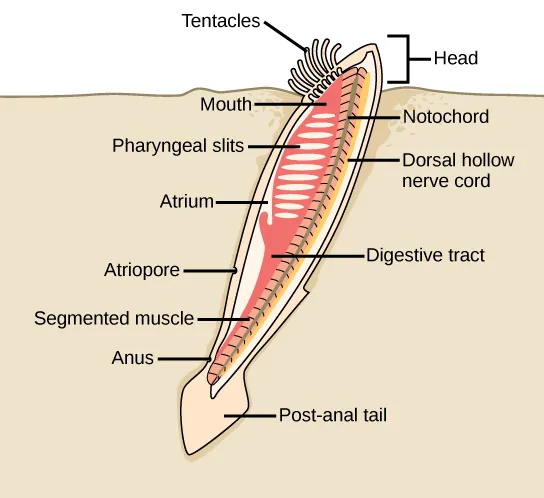
Urochordata: Tunicates
The 1,600 species of Urochordata are also known as tunicates (Figure 29.5). The name tunicate derives from the cellulose-like carbohydrate material, called the tunic, which covers the outer body of tunicates. Although tunicates are classified as chordates, the adults do not have a notochord, a dorsal hollow nerve cord, or a post-anal tail, although they do have pharyngeal slits and an endostyle.

Subphylum Vertebrata (Craniata)
A cranium is a bony, cartilaginous, or fibrous structure surrounding the brain, jaw, and facial bones (Figure 29.7). Most bilaterally symmetrical animals have a head; of these, those that have a cranium comprise the clade Craniata/Vertebrata, which includes the primitively jawless Myxini (hagfishes), Petromyzontida (lampreys), and all of the organisms called “vertebrates.” (We should note that the Myxini have a cranium but lack a backbone.)
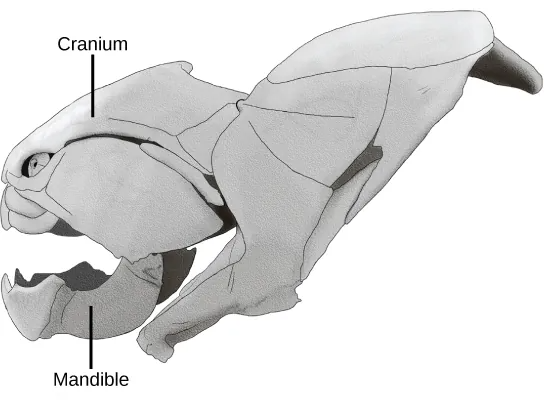
Members of the phylum Craniata/Vertebrata display the five characteristic features of the chordates; however, members of this group also share derived characteristics that distinguish them from invertebrate chordates. Vertebrates are named for the vertebral column, composed of vertebrae—a series of separate, irregularly shaped bones joined together to form a backbone (Figure 29.8). Initially, the vertebrae form in segments around the embryonic notochord, but eventually replace it in adults.
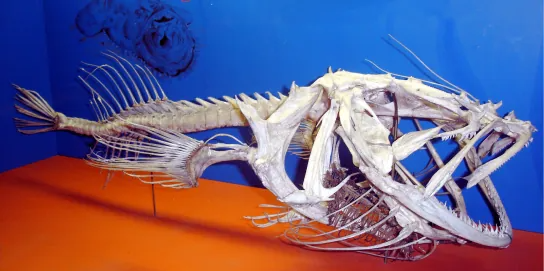
Vertebrates are the largest group of chordates, with more than 62,000 living species, which are grouped based on anatomical and physiological traits. More than one classification and naming scheme is used for these animals. Here we will consider the traditional groups Agnatha, Chondrichthyes, Osteichthyes, Amphibia, Reptilia, Aves, and Mammalia, which constitute classes in the subphylum Vertebrata/Craniata. Virtually all modern cladists classify birds within Reptilia, which correctly reflects their evolutionary heritage. Thus, we now have the nonavian reptiles and the avian reptiles in our reptilian classification. We consider them separately only for convenience. Further, we will consider hagfishes and lampreys together as jawless fishes, the Agnatha, although emerging classification schemes separate them into chordate jawless fishes (the hagfishes) and vertebrate jawless fishes (the lampreys).
Animals that possess jaws are known as gnathostomes, which means “jawed mouth.” Gnathostomes include fishes and tetrapods. Tetrapod literally means “four-footed,” which refers to the phylogenetic history of various land vertebrates, even though in some of the tetrapods, the limbs may have been modified for purposes other than walking. Tetrapods include amphibians, reptiles, birds, and mammals, and technically could also refer to the extinct fishlike groups that gave rise to the tetrapods. Tetrapods can be further divided into two groups: amphibians and amniotes. Amniotes are animals whose eggs contain four extraembryonic membranes (yolk sac, amnion, chorion, and allantois) that provide nutrition and a water-retaining environment for their embryos. Amniotes are adapted for terrestrial living, and include mammals, reptiles, and birds.

